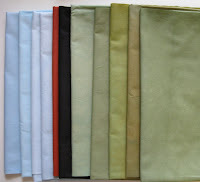In the summer of 2008, I did a week-long mixed media workshop at the Arrowmont School of Arts and Crafts. One of the results of that workshop was this pastel work--layers and layers of pastel on 9x12" rectangles of paper. I was working with an idea I had long had for a quilt about the midwestern landscape in late March. I like this work quite a lot; it hangs on the wall in our living room.
One of the important results of the Arrowmont workshop (where I also did some work with water color) was that it gave me confidence that I could mix colors in order to get the vision of color I wanted, which led me to learn how to paint fabric and to take a workshop on fabric dyeing. This past summer, I finally got around to dyeing fabric for a quilt version of the landscape. I haven't yet quilted it--still thinking about what to do--but here's the top (each block is again 9x12", total dimensions 45x60"):
And here's a table runner that I made this weekend, with smaller blocks, 3x4, for total dimensions of 12x44"

For the back and binding, I used some sage-colored Kona fabric that I overdyed with greens and brown.

I quilted with random, narrowly spaced wavy lines, which I like. Perhaps this would work for the larger version as well.
Looking at a detail of the front, you can see one problem with the quilting--the right/left edges of the blocks have gotten distorted out of line by the quilting. Some people recommend quilting the lines all in the same direction to avoid this. Others recommend alternating directions. I tried both ways in a sample, and got distortion with both methods :-( One other thing to try is even more meticulous pin-basting than I already do, perhaps taking care to pin right in the seams. If anyone has suggestions for me, I'd love to hear them!
















































